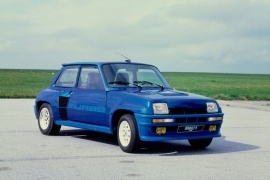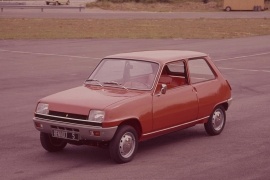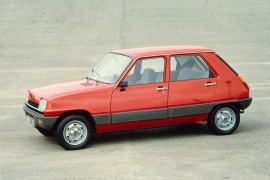RENAULT 5 Models/Series Timeline, Specifications & Photos
First production year: 1972
Engines: Gasoline
Body style: Hatchback
In 1980, Renault introduced a special version of the Model 5 to compete in the World Rally Championship; it became the fastest car produced in France.
Renault had to reconsider its strategy after losing to Lancia in the World Rally Championship. So it launched a particularly daring project: transforming the economical R5 supermini into a genuine podium-capable racing car.
The project was ordered by Jean Terramorsi, Renault's VP for production cars, based on the existing model 5. Marc Deschamps from Bertone design studio came up with the idea of installing the engine behind the seats. Thus the idea of a mid-engine race car was born. After trials and errors, it came with the prototype in 1978. Due to the FIA's regulations, Renault chose the Alpine's 1.4-liter powerplant, which was mated with a five-speed manual gearbox carried over from Renault 30.
Moreover, thanks to extensive modifications and the addition of a turbocharger and a K-Jetronic fuel-injected system, the result was a 157 hp (160 PS) powerplant that sent the torque to the rear wheels. Unlike the standard 5, which featured a torsion-beam suspension system, the 5 Turbo used a multi-link system carried over from the Alpine A110.
These modifications were placed into a car styled by Marcello Ghandini from Bertone. Apart from the front fascia that was enhanced with a fat bumper, the most significant change was behind the B-pillars. There, the wider quarter panels featured air intakes for cooling the engine and feeding the turbocharger's intercooler.
Inside, Renault installed a pair of sports seats with high-bolstered areas and four-point seatbelts. Last but not least, the dashboard was upgraded to accommodate more gauges for the boost pressure, oil temperature, and other info required by a race car.
The final version came on the market in 1980. Thanks to its under seven-second 0-62 mph (0-100 kph) run and the top speed above 125 mph (200 kph), the Renault 5 Turbo became the fastest French car of its era.
Back at the beginning of the '70s, the French carmakers provided two main options for the small segment: the Renault 4 and the Citroen 2CV. Then, in 1972, the R5 joined the pack and stirred the market.
The studies for the new vehicle started in 1967 when Renault's CEO, Pierre Dreyfuss, asked the team to design a new vehicle.
The first supermini ever manufactured by the French carmaker, the Renault 5 was revealed in 1972 as a 3-door and 5-door hatchback. The 3-door body style was based on the commercial version of the R4. Its doors didn't feature any handles. The user had to grab them from behind their edge, through a deeper dent on the bodywork.
The design was the work of Michelle Boue, a 36-year-old stylist. Renault was impressed with Boue’s drawings and quickly authorized a development program. Unfortunately, Boue didn’t get the chance to see his brainchild blossom as he died in late 1971, however, the final design was pretty much like his initial sketches.
Aesthetically, the super-chic styling of the Renault 5 featured straight lines, square headlights, and a steeply sloping rear hatch.
The Renault 5 featured wraparound plastic bumpers that were a big thing in 1971. Developed by Prost-Dame, they were high-impact resistant and the R5 was parking-proof in every crowded city.
Most of its underpinnings were carried over from the popular Renault 4, such as the longitudinal-mounted engine that drove the front wheels. The powerplants were taken from the Renault 4 and the Renault 8, a 782cc with 33.5 hp and a 956cc with 44 hp respectively.
The Renault 5 was very close to winning the European Car of the Year in 1973, however, the title was awarded to the Audi 80.
In the early seventies, the French carmaker Renault offered a very attractive vehicle for the small-segment: The Five. It was the beginning of an unknown success.
It was in 1967 with Pierre Dreyfus asked his engineers to design a new small car that would be desired by a broad spectrum of the population, fit for all occasions and seasons.
The first supermini ever manufactured by the French carmaker, the Renault 5 was revealed in 1972 as a 3-door and 5-door hatchback.
The design was the work of Michel Boue, a 36-year-old stylist. Renault was impressed with Boue’s drawings and quickly authorized a development program. Unfortunately, the designer Michelle Boue didn’t get the chance to see its brainchild blossom as he died in late 1971, however, the final design was pretty much like his initial sketches.
Aesthetically, the super-chic styling of the Renault 5 featured straight lines, square headlights, and a steeply sloping rear hatch.
The Renault 5 featured wraparound plastic bumpers that were a big thing in 1971. Developed by Prost-Dame, they were high impact-resistant and the R5 was parking-proof in every crowded city.
Most of its underpinnings were carried over from the popular Renault 4, such as the longitudinal-mounted engine that drove the front wheels. The powerplants were taken from the Renault 4 and the Renault 8, a 782cc with 33.5 hp and a 956cc with 44 hp, respectively.
The Renault 5 was very close to winning the European Car of the Year in 1973, however, the title was awarded to the Audi 80.


